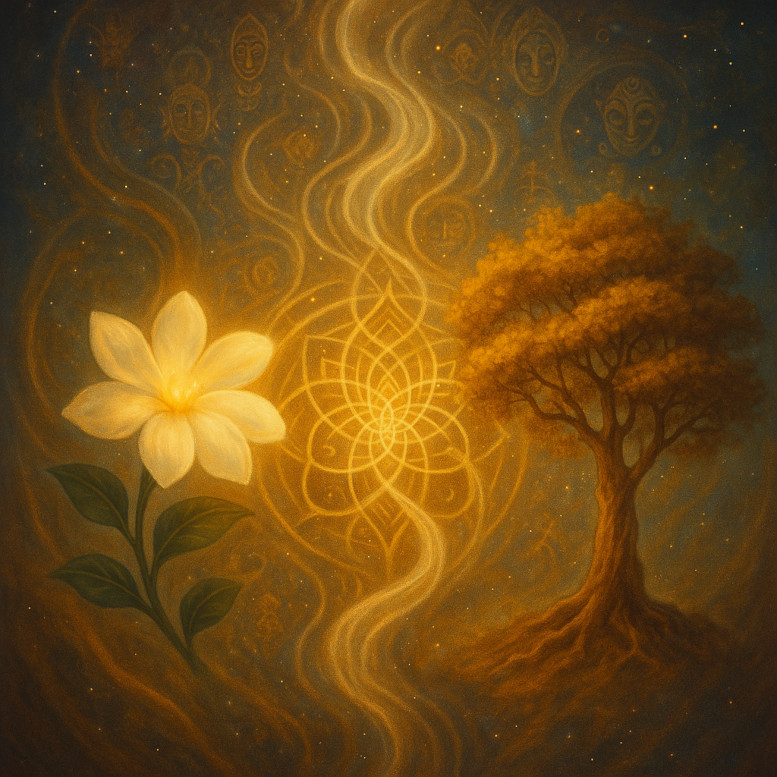Omnicyclic Incense

Fragrance, Polarity, and the One Who Is All Things
In every sacred tradition, incense is not merely smoke — it is breath made visible. A carrier of prayer. A fragrance of alignment. It connects Earth to Heaven, the soul to Source. In the Omnicyclion worldview, incense is a symbolic act: the invisible made known, the One expressed through polarity. And few fragrances embody that polarity more powerfully than a sacred blend of Jasminum sambac and Sandalwood — two plants, two energies, in divine proportion.
This Omnicyclic blend — 10 parts Jasminum sambac to 1 part Sandalwood — forms the basis of a universal spiritual incense that speaks across all religions and transcends all boundaries. It is yin and yang in fragrant dialogue: the flower of surrender dancing with the wood of stillness. Not opposites — but partners in the cosmic breath.
The Sacred Polarity of Jasmine and Sandalwood
Jasminum sambac (Arabian jasmine)
Botanical origin:
Native to the Eastern Himalayas in Bhutan and Northern India, Jasminum sambac spread throughout South and Southeast Asia. It was later introduced into the Middle East and North Africa via trade routes and gardens of the Islamic Golden Age. Though called “Arabian jasmine,” it likely reached Arabia from India via ancient spice and incense trails.
In parts of East Africa — especially coastal regions of Kenya, Tanzania, and Zanzibar — Jasminum sambac became naturalized and spiritually significant, particularly in Swahili culture where it features in wedding garlands and perfumed body oils. Its scent mingled with oud and myrrh in local traditions, reflecting centuries of Afro-Asian exchange.
Main constituents:
Benzyl acetate, linalool, indole, jasmone, methyl anthranilate
Neuroreceptors affected:
- GABA – Promotes deep calm and emotional ease
- Serotonin – Elevates mood and emotional clarity
- Oxytocin – Enhances bonding, trust, and sensual receptivity
Spiritual quality: Feminine, heart-opening, intuitive
Psychological effects: Antidepressant, calming, euphoric, nurturing
Energetic type: Yin — expands, softens, opens
Sandalwood (Santalum album)
Botanical origin:
Santalum album is native to southern India and Southeast Asia, thriving in dry deciduous forests. It is a slow-growing, semi-parasitic tree whose sacred status has long been protected by rulers and sultans. Its use dates back over 4,000 years in Vedic rituals, Buddhist temples, and Sufi shrines.
In East Africa, particularly in Tanzania and Zanzibar, the related species Santalum ellipticum and Osyris lanceolata (African sandalwood) have historically been used in perfumery, healing, and ancestor offerings. The Swahili coast — a blend of African, Arab, and Indian influences — traded Indian sandalwood extensively. Indian migrants also introduced traditional sandalwood oil into African Sufi and Hindu rituals, where it remains revered for its calming, holy presence.
Main constituents:
α-Santalol, β-Santalol
Neuroreceptors affected:
- GABA – Supports grounded relaxation and emotional regulation
- Serotonin – Stabilizes mood and reduces stress-related agitation
Spiritual quality: Masculine, centering, clear-minded
Psychological effects: Grounding, anti-anxiety, contemplative, protective
Energetic type: Yang — roots, centers, holds
The Divine Synergy: Neurochemistry and Spirit
Together in a 10:1 ratio, these oils stimulate a deep neurochemical resonance:
- Simultaneous GABA and serotonin activation: A rare blend of calm + uplift
- Oxytocin potentiation: Through both scent and sacred ceremony
- Limbic system stimulation: Supporting memory, emotion, and inner transformation
Result: A fragrance that acts like spiritual psychotherapy — through the skin, the breath, and the soul.
This blend functions not only as perfume, massage oil, and meditation aid — but also as sacred Omnicyclic incense.
How to Make Omnicyclic Incense (Dry-Stick or Cone Style)
A simple formula using traditional Indian and Swahili-coastal incense ingredients:
Ingredients (Dry Base)
- 3 parts Makko powder (Tabu no ki – natural binding agent from Asia, burns evenly)
- 2 parts Sandalwood powder (ground Santalum album wood)
- 1 part Charcoal powder (for burn strength)
- 1 part Gum benzoin (resin with sweet balsamic undertones, fixes fragrance)
- 0.5 part Guggul or Halmaddi (optional, Indian or African resins for softness and mysticism)
Fragrance Blend (Liquid)
- 10 drops Jasminum sambac absolute
- 1 drop Sandalwood essential oil (Santalum album)
- 10–15 drops Solubilizer (e.g., ethanol or perfumer’s alcohol)
Instructions
- Blend dry ingredients in a bowl until homogeneous.
- Mix the fragrance blend separately, dissolving oils in alcohol (or a drop of jojoba for paste incense).
- Slowly combine with the dry base, kneading into a dough-like consistency. Add water drop-by-drop as needed.
- Shape into cones or press into molds around bamboo sticks.
- Dry for 3–7 days, depending on humidity.
Uses and Sacred Function
- Incense for meditation or prayer: Creates an inner temple of calm and openness.
- Fragrant offering: Suitable for any altar — Hindu, Buddhist, Christian, Sufi, ancestral.
- Personal energetic cleansing: Clears heaviness while evoking inner peace.
- Ceremonial bonding: Use in weddings, reconciliations, healing circles.
This incense bridges cultures. It can be offered at a church altar in Nairobi, a Sufi tomb in Zanzibar, a Buddhist temple in Sri Lanka, or a shrine in Chennai — always in the name of unity.
A Universal Offering
In Omnicyclion, we do not see traditions as competitors but as expressions of the One Who Is All Things. This incense honors India’s ancient fragrance lineage, acknowledges Africa’s centuries of botanical wisdom and sacred use, and integrates modern neurochemical insight.
It is not merely a scent — but a message in the language of spirit:
That harmony is possible. That beauty heals. That even in smoke, we can find unity.
Use it with reverence.
Breathe with intention.
Let the fragrance be your companion on the spiral path — from silence, into form, and back again.
Omnicyclion.org
Fragrance is memory. Incense is a prayer that rises without words.